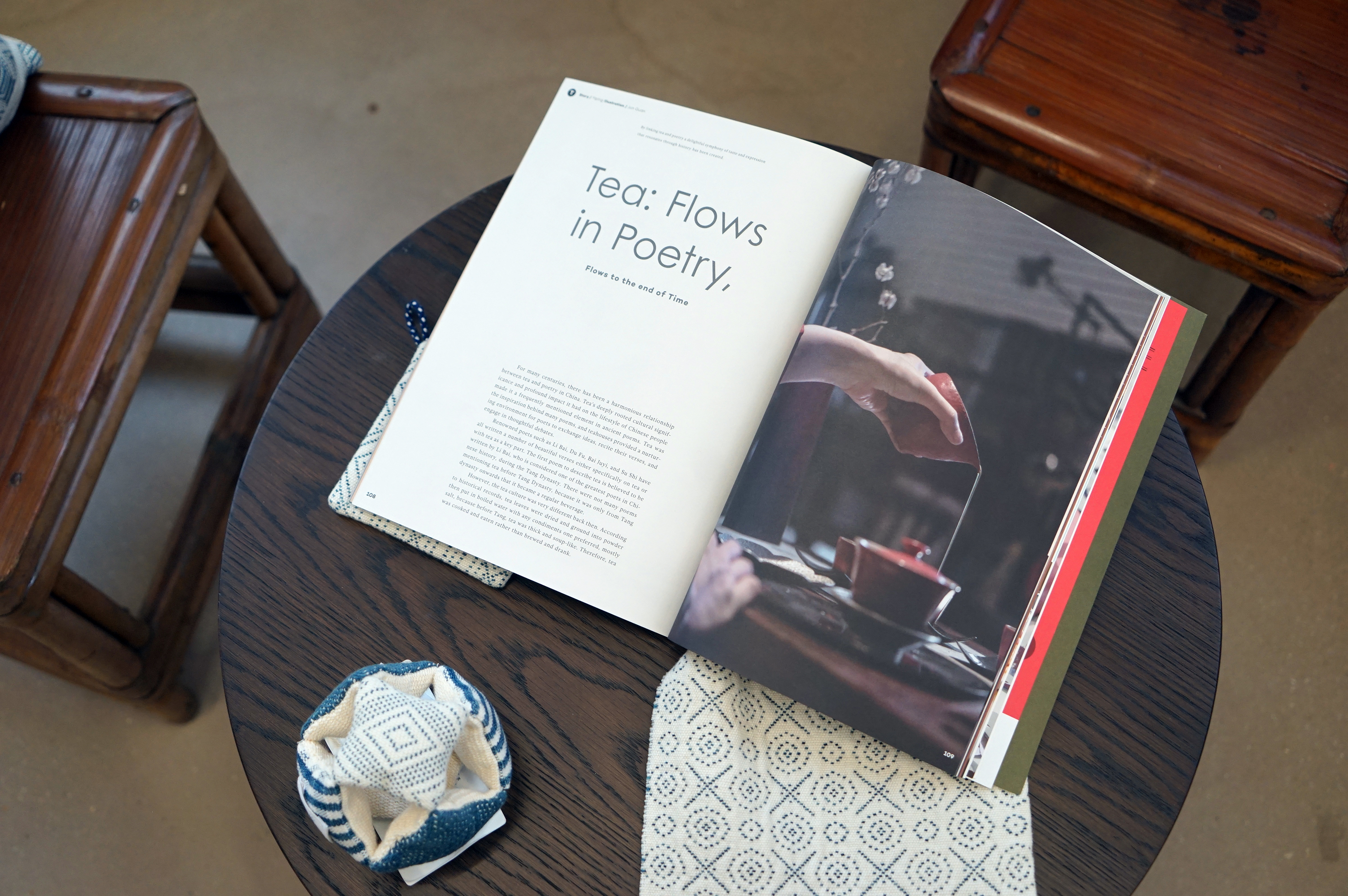
For many centuries, there has been a harmonious relationship between tea and poetry in China. Tea’s deeply rooted cultural significance and profound impact it had on the lifestyle of Chinese people made it a frequently mentioned element in ancient poems. Tea was the inspiration behind many poems, and teahouses provided a nurturing environment for poets to exchange ideas, recite their verses, and engage in thoughtful debates.
Renowned poets such as Li Bai, Du Fu, Bai Juyi, and Su Shi have all written a number of beautiful verses either specifically on tea or with tea as a key part. The first poem to describe tea is believed to be written by Li Bai, who is considered one of the greatest poets in Chinese history, during the Tang Dynasty. There were not many poems mentioning tea before Tang Dynasty, because it was only from Tang dynasty onwards that it became a regular beverage.
However, the tea culture was very different back then. According to historical records, tea leaves were dried and ground into powder then put in boiled water with any condiments one preferred, mostly salt, because before Tang, tea was thick and soup-like. Therefore, tea was cooked and eaten rather than brewed and drank.
Tea culture was further developed in the next dynasty, Song. The most notable change was that people started to consume the liquid of the tea. The way to serve tea was also changed to “dian cha”, meaning “pointing tea” in Chinese. Dian cha was very similar to the way Japanese serve matcha today, which is to mix green tea powder with hot water and then whisk it well till a layer of fine foam appears on the surface.
It was only from the last two dynasties that drinking the liquid of loose tea leaves soaked in hot water became the dominant way in China, which is still one of the main methods to enjoy tea today. However, in the past few decades, to suit the rapidly developing society and beverage market, tea culture in China has been undergoing big changes once again.
China has a leading position in the global tea market , taking up nearly half of the product ion and a third of consumption. According to a survey by Statista, nearly 95 percent of Chinese were tea drinkers, and almost a third drink tea every day. That is to say, in such a mature market, it will take some real efforts to further develop it.
Businesses invested a lot in the evolution of tea products. Tea is no longer limited to tea leaves and pure tea beverages. Flavored tea has become a widely consumed drink in modern Chinese people’s life, and the most common thing to do is to mix tea with fruits, such as lemon with black tea and peach with oolong tea, both of which are popular flavors among young Chinese. Flavored tea is now mainly in 2 types of products, one is freshly made beverage, such as new style tea drink, the other is ready-to-drink (RTD) products sold both online and offline.
The rise of new style tea drink has been a phenomenon in the past few decades. New style tea, also known as bubble tea, is the most popular beverage in China among young people at the moment . I t focuses on seasonal ingredients , fast changing menus, high quality, brand image, and current social trends. Similar to new style tea, RTD tea also focuses on the above features, but one difference between the two is that new style tea doesn’ t necessarily need needs to have tea in it , such as mashed taro with milk. That said, the majority of new style tea still contains real tea.
Apart from the liquid tea product, tea as leaves or powder is also a bi g category of the market . New trends include freeze-dried instant tea. Unlike ground tea leaves, it is the powder form of the beverage.
The marketing campaign of tea products has also gone through different stages, which is often a reflection of the society at any given time. In recent years , there has been one social phenomenon in China that has had a great impact, and it is the revitalization of traditional Chinese culture. For a period of time, especially after the open up of China market, traditional Chinese culture was not quite so popular among young people, who were dazzled by the western culture and thought traditional Chinese culture out of date and tacky. As China started to rise as a key global power, the growing confidence and pride of being Chinese brought the traditional culture back on stage.
The tea market took a quick response to the change, and one of the factors is the reconciliation of tea and poems.
In the RTD tea market, a typical case is Yin Bing Shi Tea Collection. It is a Taiwanese brand, and its slogan is “Having tea in poems, in spring”. Yin Bing Shi Tea Collection doesn’t position itself as a highend brand, its target customer is school students and young people. Instead of investing in new product R&D, it attracts its customers by constantly changing the poems printed on the carton. Yin Bing Shi Tea Collection uses modern poems, and many poems were contributed by well known literary figures in Taiwan, such as lyricist Vincent Fang and writer and TV presenter Kevin Tsai. Vincent Fang wrote many wide spread lyrics for Jay Chou, a famous singer known for blending traditional Chinese culture with western music styles in his songs. The poem Vincent wrote for Yin Bing Shi Tea Collection is short and beautiful.
“In the sweet gentle spring
My heartbeat drops on your side of the world
A cup of tea I am savouring
Together is the day spent with you”

Poems like that helped the brand to create a refreshing and literary image, which is adored and approved by young people.
In the flourishing new style tea market, many big brands have adopted the strategy to use poems in their marketing campaign.
Cha Yan Yue Se, whose English brand name is Sexy Tea, is one of the most successful new style tea chains in the past decade. I t s whole brand design is very traditional Chinese, and it claims to be the first proper Chinese new style tea in modern China. Though unlike Yin Bing Shi Tea Collection, Sexy Tea doesn’t have poems as its slogan or on its regular packaging, but poems, especially traditional Chinese poems, are in its gene. Many of the brand’s signature drinks are named after well known lines from traditional poems, such as “Fu Sheng Ban Ri”, meaning “half day in illusive life”, is from a famous line in a poem by Tang poet Li She, “Tou De Fu Sheng Ban Ri Xian (half a day’s relaxation stolen)”.
Other top brands in new style tea market also had several marketing campaigns with poems as the theme.
Earlier this year, Heytea launched its seasonal menu with lychee as the main ingredient, and one of the most accomplished figures in Chinese literature, Su Shi, as the theme. Apart from his achievement to Chinese literature, Su Shi is also known for a strong passion towards food, and there is one famous line in his poems that is expressing his love for lychee, “savoring 300 lychees daily, converting to a Lingnan local happily”. Therefore, Su Shi and his poems were on the limited edition packaging and other promotional materials, as well as on promotional events.
Another big player in the new style tea market, Lelecha, also launched a poem themed charity event last year. It was a collaboration with China Union Pay, who started a series of “Poems on POS” activities since 2019. Apart from printing poems written by children from under-developed regions on receipts and cup sleeves, customers can spend 1CNY on a poem collection by these children, and the money would all be donation for establishing better arts courses in under developed areas.
In the tea leaves market, Xiao Guan Tea, meaning “small boxed tea”, is one of the major brands. It’s known for the sleek luxurious aluminium small-sized container and a high standard in tea quality. Xiao Guan Tea’s promotion contents on its WeChat official account are well known for its poetic style. For example, when launching Shi Feng Long Jing tea, the promotion slogan was “In front of the mountain is spring, and spring is not needed once back from Shi Feng Mountain”. The beautiful language, as well as the modern package design, has made Xiao Guan Tea especially popular among females between 18-40.
As a defining part of Chinese culture, tea has gone through many changes in history, to better suit people’s taste in different eras, and to explore a way to constantly revitalize and develop. From this perspective, so i s poetry. The appreciation Chinese people have for literature never changes, and poetry, though in different forms, remains in people’s lives.
When tea and poetry are put together, it is hard to say which is promoting which. By linking the two elements, a delightful symphony of taste and expression that resonates through history has been created, which paved the way for a more profound understanding of art, literature, and human connection for Chinese people.
In modern times, with the rise of Chinese fad, tea and poetry once again found each other’s hands. Through those elegant marketing campaigns, a revived Chinese culture rides on the prevalence of a renewed tea market, reaching the young generation in China, and the vast land outside of China.









NO COMMENT